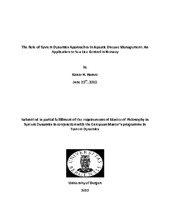| dc.description.abstract | Different methodologies have been used to model the epidemiology and economics of aquaculture diseases, including input-output models, benefit- cost analysis, linear programming, simple spreadsheet-based models, compartment models based on differential equations, and spatial models. Despite the advantages that each of these different models provide, there is a need to develop a more integrated approach to the epidemiology and economics of disease that better represents and captures existing feedback mechanisms, interventions to control aquatic disease, and the economic consequences of these interventions on producer behavior. System Dynamics (SD) modeling approaches have utility in this context. While SD has been used to model terrestrial animal diseases, its application in fisheries has been limited to questions of stock management. In this paper, we apply system dynamics modeling in the context of sea lice control in Norwegian farmed salmon. Separate models of sea lice and salmon growth evolution were designed and integrated to capture the feedback between them. Different simulation scenarios highlight the benefits of the approach. | en_US |
